As an Amazon Associate, I earn from qualifying purchases with no additional costs for you.
When it comes down to celebrating, there is no better way to do so than popping open a bottle of bubbly. Here are some pro tips and tricks on how to store and serve your sparkling wines, no matter what the occasion is.
Sparkling wine should be kept in a climate-controlled wine refrigerator at a temperature of 50°-55°F, humidity levels of 50-70% in darkness with the bottles lying down with labels facing up. Opened sparkling wine should be kept in a kitchen refrigerator at a temperature of 40°-45°F standing upright with a Champagne stopper applied to prevent bubble loss. Unopened vintage sparkling wines can be stored for 7-10 years, unopened non-vintage sparkling wines can be stored for 2-4 years, and any opened bottle of sparkling wine will need to be consumed with 3-5 days of opening.
To further break down the storage durations for sparkling wine, please refer to the below table.
| Type of Sparkling Wine | Maximum Storage Duration |
|---|---|
| Vintage Sparkling Wine | 7-10 years |
| Non-Vintage “Champagne Method” Sparkling Wine | 3-4 years |
| Non-Vintage “Tank Method” Sparkling Wine | 2 years |
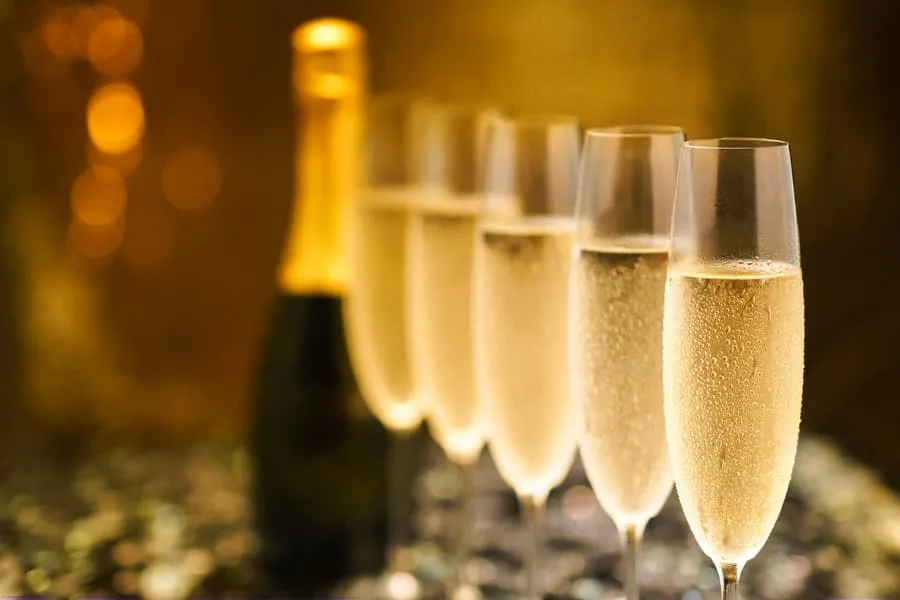
TIP: If you want to check out the best refrigerator for wine storage, I recommend trying out the Avation (18 bottles) compressor refrigerator with Wi-fi smart app control cooling system. You can find this refrigerator by clicking here (Amazon link).
Quick Breakdown of Sparkling Wine Types
Recommendation box: Everything you need to enjoy your wine as much as possible. All recommended products are personally tested and regularly used by experts from this website (Amazon links):
> Ivation Wine Cooler – Energy-efficient wine cooler for 18 bottles with Wi-fi smart app control cooling system.
> Wine Rack – Beautiful, elegant wood rack for up to 7 bottles and the choice of vertical or horizontal storage.
> Durand Wine Opener – Classic vintage wine opener (we like all these classic staff).
> YouYah Iceberg Wine Decanter – The most beautiful and handy wine decanter we personally use.
> Bormioli Rocco Wine Glasses – A set of eight elegant and traditional wine glasses made in Italy.
> Vintorio Wine Aerator – Simple but really useful wine aerator for a reasonable price.
> The Original Vacu Vin Wine Saver – The best wine saver on the market in a package with two vacuum stoppers and two wine servers.
And if you want to become a true connoisseur of wine, we recommend reading the book Wine Folly: The Essential Guide to Wine (Amazon link), where you will find all the information you need about winemaking, wine varieties, flavors, and much more.
Champagne
Champagne is a sparkling wine that comes from the Champagne region in France. The name Champagne is very protected by the Champagne Committee. This is why the only wineries allowed to print Champagne on their label have to be from the region itself.
While there are a few different stories floating around about who created Champagne first, the main point is that this was done by using the Champagne Method. The Champagne Method, or “Traditional Method” is accomplished by fermenting the grape juice into a base wine.
This is then bottled with some active yeast and sugar, causing the wine to ferment for a second time. This second fermentation is when the bubbles occur. To this day, all Champagnes are made in this fashion.
Champagne bubbles are known to be fine, unlike bubbles you would find in an average beer. The pressure in a Champagne bottle can be anywhere between 70-90 pounds per square inch, about 2-3 times the pressure in your car’s tires!
This results in a lively, mesmerizing chimney of bubbles in your glass. Vintage wines of this category can be stored for 7-10 years whereas non-vintage wines need to be consumed within 3-4 years for best results.
TIP: There is a correct way to store wine for the best results. Discover the best storage methods for red wine here and the complete guide on how to store white wine here.
Prosecco
Named after the village of Prosecco in Italy, this sparkling wine is made from the Glera grape variety. The grape variety itself used to be called Prosecco but was changed to Glera in 2009, to furthermore protect the name Prosecco.
Prosecco is wonderfully diverse, as it can be made in a sweet or dry style. Unlike Champagne, most Prosecco is not fermented in the bottle. Instead, the second fermentation of the base wine is done in a large, pressurized tank. This is known as the “Tank Method”.
This results in a slightly less pressurized sparkling wine than Champagne when bottled. The bubbles are lighter and slightly bigger than those in Champagne. This type of wine is best stored for a maximum of 2 years.
Cava
This sparkling wine is mostly produced in the Catalonia region of Spain, also known as “Cava Country”. Just like Champagne, Cava can only be called Cava if secondary fermentation happens in the bottle.
The most popular and traditional grape varieties used to make Cava are Macabeo, Parellada, Xarel-lo (Pronounced Zuh-RELL-o). Other grapes that are allowed to be used are Chardonnay, Pinot Noir, Grenache, Monastrell, and Subirat.
Cava is simply divine with clean, zesty, and floral notes, and it has great aging capabilities thanks to its solid acidity level. With time, it can develop extraordinary notes, such as baked apples and almonds.
That’s enough to make anyone dream of the sparkling blue Catalonia coast with a glass of sparkling Cava in hand. Cava is best stored for 3-4 years.
Cremant & Mousseaux
Cremants and Mousseaux refer to French sparkling wines that have less pressure than the average Champagne. Mousseaux is made with other methods than the Champagne Method, such as the Tank Method. This produces bubbles that are mild and creamy. No wonder it’s called a Mousse…oh!
Cremants have been known to compete with Champagnes, having perfectly balanced acidity, fine and silky bubbles, and beautiful aromatic complexity. The best storage duration for this type of sparkling wine is about 2 years.
Sparkling Shiraz, Lambrusco, & Other Sparkling Reds
Dating back to antiquity, red sparkling wines are finally picking up the global recognition that they deserve. These brilliant wines are made in all kinds of styles, whether that is sweet and tangy, or bold and dry. You should probably store these types of red sparkling wines for 3-4 years.
Storing Sparkling Wines
Opened Bottles
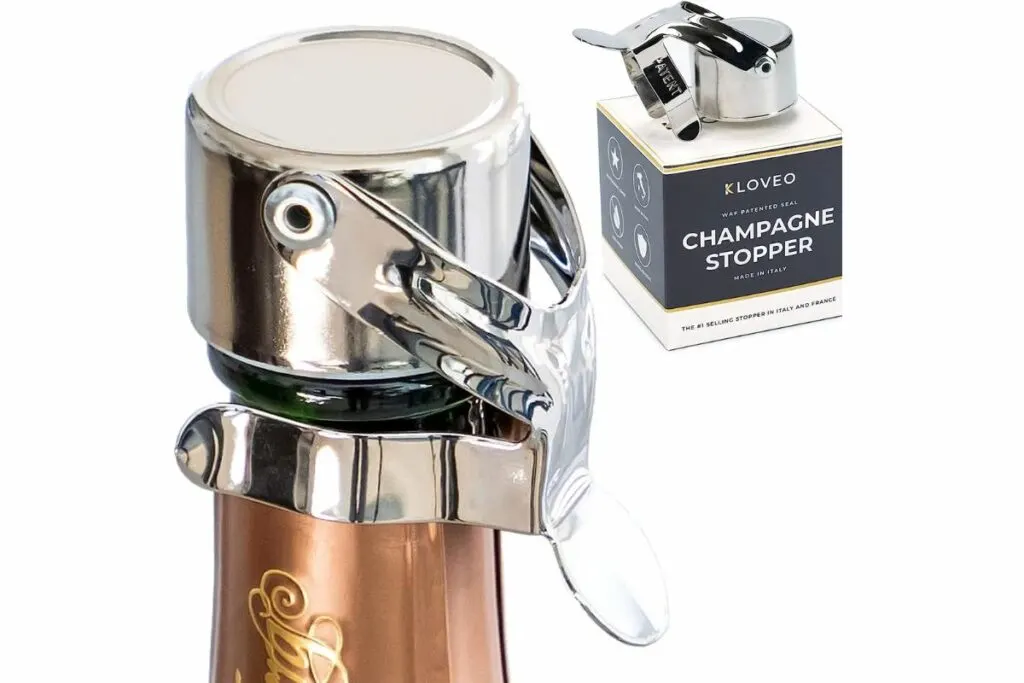
Champagne Stoppers by KLOVEO
There are always a couple of rules that you must follow to correctly preserve an opened bottle of bubbly. Firstly, make sure you have a Champagne stopper. This magical little tool is extremely cheap, starting at about $5.
It is designed to seal the sparkling wine, ensuring no carbon dioxide slips out. It also latches onto the neck of the bottle, so it doesn’t go flying off as pressure builds. This model is one of the best ones available on Amazon, sure to do the trick.
Secondly, always store the bottle in a cold place. A refrigerator or wine fridge is the perfect place for this. The carbon dioxide preserves better at a cooler temperature, especially if already exposed to more oxygen.
Unopened Sparkling Wine
Storing unopened bottles of sparkling is a bit simpler than already opened bottles, in the sense that there are no specific tools needed. However, it is a little trickier with the temperature.
Bottles of sparkling that have already been opened are perfectly fine being kept at a cooler temperature because the bubbles will only have a life of 3-5 days maximum anyways.
Unopened bottles should be stored at a consistent temperature of about 50°-55°F. This is warm enough for the bubbly to continue developing its characteristics while keeping it cold enough for preservation.
How Long Can Sparkling Wine Be Stored?
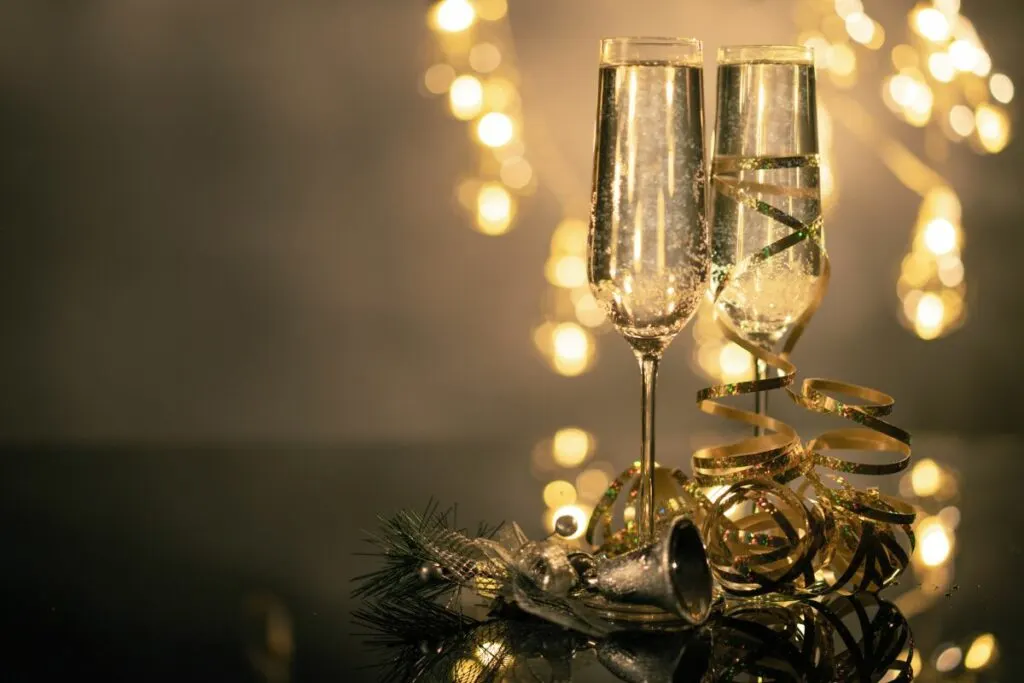
How Long Does Opened Sparkling Wine Last?
Opened bottles of sparkling wine will last 3-5 days if you use a Champagne stopper to reduce bubble loss and store the bottles in a kitchen refrigerator at a temperature of around 40°-45°F. Since sparkling wines start losing bubbles immediately upon opening, it is best served within the 1st day.
TIP: Are you interested in buying a wine stopper? We’ve personally tried and recommend buying one of these wine stoppers (Amazon links):
- The Original Vacu Vin Wine Saver: Our top choice. Very easy-to-use wine stopper/saver. You can enjoy a glass of fresh wine whenever you want without worrying about wasting any.
- EZBASICS Wine Saver: Great alternative to Original Vacu Vin Saver. This wine stopper keeps the flavor of wine for up to one week.
- Champagne Stopper by MiTBA: Wine stoppers for sparkling wines are different. This wine stopper seals your bottle and increases the pressure so your beverage’s bubbles won’t go to waste.
TIP: Is wine an acquired taste? Can you learn to love it? Find out here! To learn how heat impacts sparkling wine and what you can do to protect it, read this helpful article.
How Long Can Unopened Sparkling Wine Be Stored?
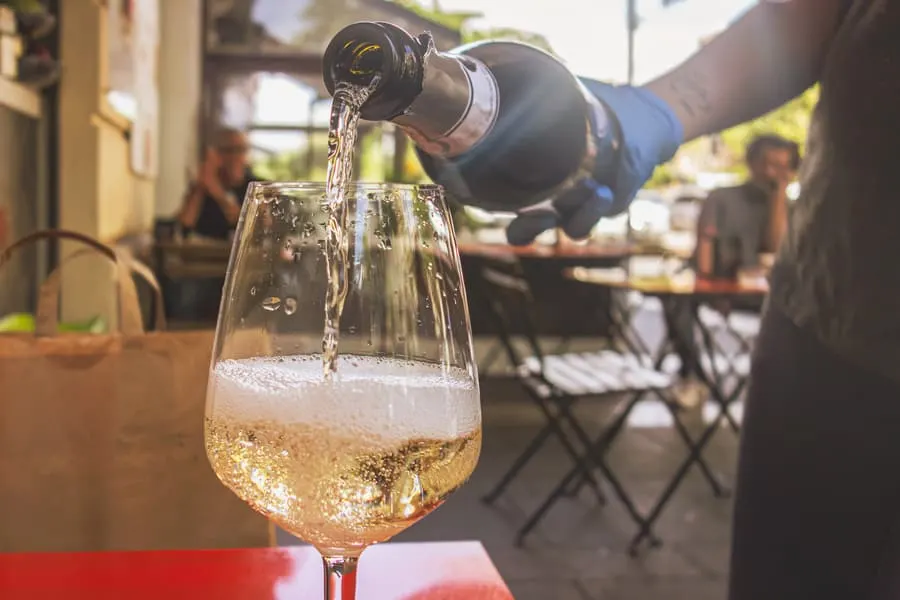
Unopened vintage Champagnes and other sparkling wines can be stored for 7-10 years safely, non-vintage “Champagne Method” sparkling wines can be kept 3-4 years, and non-vintage “Tank Method” sparkling wines should be stored a maximum of 2 years.
All unopened sparkling wines should be stored in a dark location at a temperature of 50°-55°F, humidity around 50-70%, lying on their sides with labels facing up.
TIP: Having quality storage racks for your wine is not only practical but can also serve as a nice design accessory for your home. We loved these (Amazon links):
- Ferfil Wine Rack (10 Bottles): Concertina/scissor fold wooden wine rack made of solid, eco-friendly wood.
- Gusto Nostro Wood Wine Rack: Beautiful, elegant design, the possibility of storing up to 7 bottles, and the choice of vertical or horizontal storage.
The reason you should keep labels facing up is it will be easier to identify the bottles without having to twist and turn them, which could shake up the tartaric acid crystals, or any sediment that could have settled on its side. That usually happens with older bottles that have been resting for a while.
The complete answer depends on what kind of sparkling we are talking about. Vintage Champagnes can be stored as long as desired, whilst a simple Mousseaux should probably be consumed within a couple of years of purchase.
I once tasted a vintage 1943 Pommery Champagne…It was absolutely stunning, but it did not have any bubbles to it. This does not mean that it was spoiled. The C02 eventually just seeped out through the cork while it was delicately aging. Vintage sparklings are usually safe to keep between 7-10 years with a good chance of still having bubbles, (and a nice bouquet of secondary aromas).
TIP: A suitable wine glass is the basis for enjoying well-being while drinking your favorite wine variety. Here are our favorite ones (Amazon link):
- Bormioli Rocco Crystal Wine Glasses: A set of eight elegant and traditional wine glasses made in Italy for a reasonable price.
- Riedel VINUM Wine Glasses: Luxury set of two wine glasses suitable for any occasion. We just love them!
- Schott Zwiesel Tritan Crystal Glasses: If you like unusual alternatives, a set of six stemless glasses made of crystal glass.
Non-vintage sparklings that are made with the Champagne Method can be kept for about 3-4 years before beginning to lose their backbone of acidity and bubbles. Other sparkling wines that have less pressure, such as ones made with the Tank Method, can be stored for a maximum of 2 years.
If waiting longer, you could end up with an acidless, flat wine that doesn’t carry its best potential aromas anymore. This is what sommeliers refer to as “the skeleton” of the wine. Wines, whether sparkling or not, should always be consumed at the peak of their life!
Best Places To Store Your Sparkling Wines

Refrigerators
While a great way to serve your sparkling wine briskly, kitchen fridges tend to drop to about 45°F, which is a bit too chilly for constant storage.
Use the refrigerator to store sparkling wines that will be enjoyed within a week…or weekend in many cases! This is a great place to store already opened bottles as well.
If possible, store bottles laying down on a normal shelf instead of the door shelves. Refrigerator doors get opened a lot (at least in my house), which causes more vibration that your bottles of bubbly don’t need.
TIP: Most wines go bad once you pop the cork within a day or so. But a Coravin Wine Preservation system (available for a great price on Amazon) can extend the life of your opened wine for weeks or even months. It is awesome. You should check it out to see if it fits your lifestyle.
Wine Cellars
Whether you have a temperature-controlled cellar built into your home, or you use your basement as your own personal wine cellar, there are a few things to note to ensure your sparkling wines stay in tip-top shape.
If possible, make sure the temp of the cellar is always around 50°-55°F. Consistency can’t be stressed enough when it comes to storage.
Wine can spoil after just one major temperature fluctuation. This is why homemade wine cellars are not always the best option to store sparkling wines unless you have a temperature-controlled unit.
It’s lovely to sip a glass of sparkling wine on a sunny day, but when it comes to storage, sparklings should stay out of the light as much as possible. Try to create a cellar that has no direct sunlight streaming in.
Wine Fridges
Ideally, wine fridges are the best place to store your sparkling wines, regardless of how long you’re cellaring them for. That being said, if you want to store a sparkling that has already been opened, it might be a better idea to store it in the kitchen fridge. It will remain colder (which means less time chilling in an ice bucket), and the bottle can stay upright.
TIP: Discover the best current wine refrigerators for Champagne storage with this comprehensive list and buyer’s guide. This article explains how to store wine properly without a wine refrigerator.
If you use a Champagne stopper, it shouldn’t be a problem to store the bottle laying down, but the tipping is just more movement that can cause the bubbles to fizz out faster. Other than that, Champagne bottles should always be stored laying down, with the labels facing up.
Some (if not all) use LED light bulbs that do not disturb the precious cellar sleepers. Some Champagnes that age beautifully, such as the 2012 Louis Roederer ‘Cristal’, are bottled in clear glass…making them ultra-sensitive to other lights. The LEDs are a great solution.
(Interesting fact: In 1876, the Louis Roederer Cristal Champagne bottles were made clear with no punt in the bottoms, by the request of Alexander II, Tsar of Russia. He was afraid of someone putting a bomb into his bottle!)
Serving Temperature Of Sparkling Wines
The ideal serving temperature for sparkling white wine should range between 44°-47°F and for sparkling red wine, 50°-53°F is ideal.
When prepping sparkling wine before serving, a bucket of ice water is the quickest and most effective way to chill your sparkling wine before serving.
Twisting the bottle every few minutes will evenly distribute the cold throughout the wine. Unless you’re indulging in a bubbly red, sparkling wine should always be served very chilled.
What about the top of the bottle that isn’t submerged in icy water? When ready to serve, take the bottle out of the bucket, and slowly tilt the bottle upside down a couple of times.
This will also evenly allocate that chilly temp (be sure to do this slowly, or you’ll get sprayed with bubbly as if you are in an NFL locker room after the big win!)
Sparkling reds are a bit more complex. Ideally, these should be served between 50°-53°F. This way, the tannins of the wine are not numbed out, yet the bubbles are still crisp and refreshing.
Signs That a Sparkling Wine Has Gone Bad
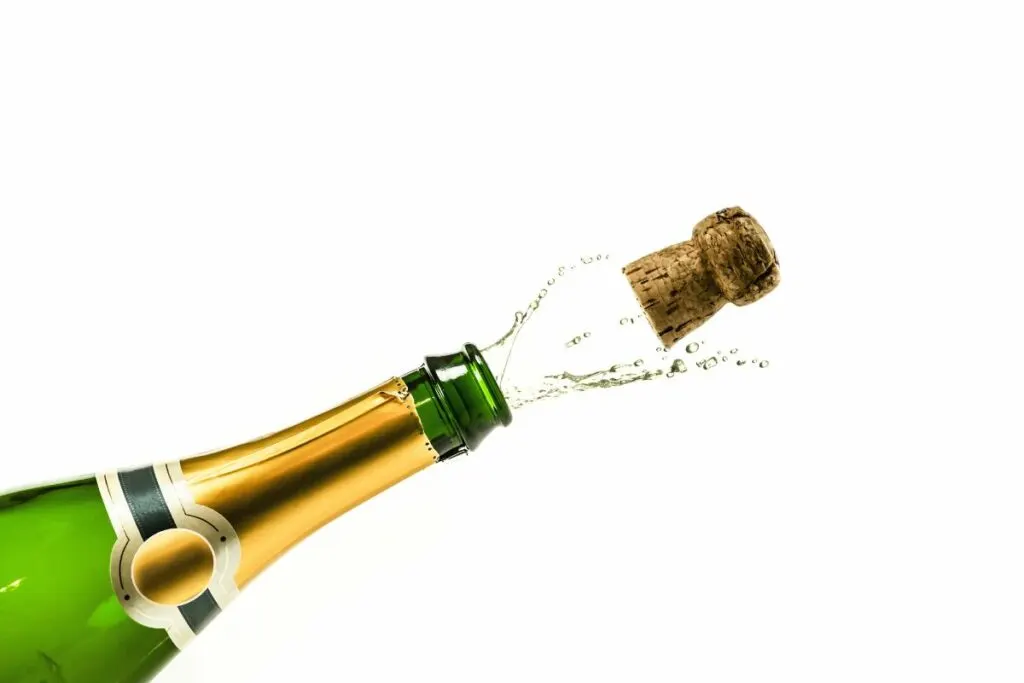
While there are various reasons as to why a sparkling wine can go bad, the first sign to look for is the bubble texture and consistency.
Did it seem like no pressure was released when the cork was popped? In opposition, if sparkling wine is too hard to pop open, that can be a sign of flatness, rather than a lot of pressure.
The first thing to leave the wine after a bottle of sparkling has been opened…is the fizz. When drinking a bottle that has already been opened days before, the bubbles should still be lively and present. (Making sure to store open bottles correctly pays off!)
Another sign that sparkling wine has gone bad is the aroma. If it smells like musty cardboard, there’s a good chance that the wine is corked. An unpleasant, vinegar or acetone-like aroma could mean that the wine is oxidized.
Conclusion
Sometimes sparkling wines can be spoiled for reasons beyond our control, but storage is always the most important aspect to focus on when it comes to enjoying your precious bubbly.
It’s always important to store your sparkling wines at a temperature of about 50°-55°F, keep them away from light, and invest in a Champagne stopper if you have the discipline to save a bottle for more than one day! Cheers!
TIP: Check out this page for a complete list of wine products and accessories I love. You’ll find my recommendations for wine refrigerators, decanters, and aerators and the best place to buy wine online. Click here to see the complete listing.
